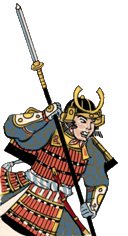

At the end of the 14th century, towards the end of the Kamakura period, even senior samurai often used lightweight dō-maru. The artistic decoration of ō-yoroi reached its peak around the time of the Genpei War at the end of the Heian period. Leather and or iron scales were used to construct samurai armour, with leather and eventually silk lace used to connect the individual scales (kozane) from which these cuirasses were now being made. Japanese armour makers started to use leather (nerigawa), and lacquer was used to weatherproof the armour parts. The Japanese cuirass evolved into the more familiar style of armour worn by the samurai known as the dou or dō. Luxurious and heavily armed ō-yoroi were worn by senior mounted samurai, while the lighter dō-maru were worn by lower-class infantry samurai. ĭuring the Heian period (794-1185), the unique Japanese samurai armour ō-yoroi and dō-maru appeared. Tankō, worn by foot soldiers and keikō, worn by horsemen were both pre-samurai types of early Japanese cuirass constructed from iron plates connected together by leather thongs. Cuirasses and helmets were manufactured in Japan as early as the 4th century CE. Edo period, 19th century, Tokyo Fuji Art MuseumĮarliest Japanese armour is thought to have evolved from the armour used in ancient China. Cloud dragon is drawn using maki-e technique. Gusoku Armour with a medieval revival style. Kasuga Grand Shrine is also known as a treasure house of valuable armour. It houses 40% of Japanese armour that has been designated as a National treasure and an Important Cultural Property. Ōyamazumi Shrine is known as a treasure house of Japanese armour. When a united Japan entered the peaceful Edo period, samurai continued to use both plate and lamellar armour as a symbol of their status. As a result, a new style of armour called tosei-gusoku ( gusoku), which means modern armour, appeared. This was the first time matchlock muskets were imported, and as they became mass-produced domestically, samurai needed lighter and more protective armour. In the 16th century, Japan began trading with Europe, during what would become known as the Nanban trade.

Leather and/or iron scales were also used to construct samurai armours, with leather and eventually silk lace used to connect the individual scales (kozane) of these cuirasses.


The Japanese cuirass evolved into the more familiar style of body armour worn by the samurai known as the dou or dō, with the use of leather straps (nerigawa), and lacquer for weatherproofing. During the Heian period (794-1185), the unique Japanese samurai armour ō-yoroi and dō-maru appeared. It is thought they originated from China via Korea. Scholars agree that Japanese armour first appeared in the 4th century, with the discovery of the cuirass and basic helmets in graves. A man wearing Samurai armor and jinbaori (sleeveless jacket) spins around, 2019


 0 kommentar(er)
0 kommentar(er)
